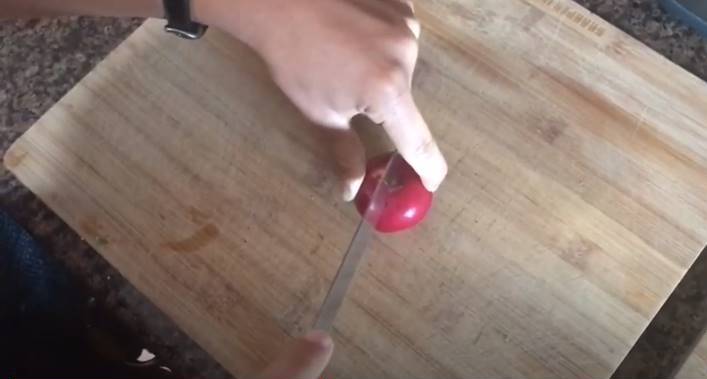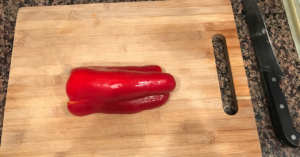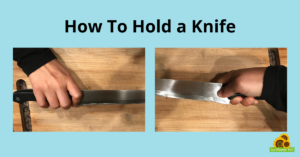Safe Knife Skills
March 10, 2021

An essential cooking skill is learning to safely use a knife! I know that sometimes, knives can be a little scary. But with some knowledge and preparation, knives can be a great and safe way to prepare delicious snacks and meals from scratch for yourself, friends, and family! If you are not ordinarily able to use knives without assistance, please ask your caregiver to help you with the tips below.
My adaptive cooking blog article last month, highlighted several different tools you can use to prepare produce. This month, I’ll focus on how to use a knife safely in the kitchen. Knives are used to cut and prepare ingredients for recipes, and to make foods smaller and more easily enjoyed! During my virtual Cooking Class, I demonstrate, teach, and practice safe knife skills in order to chop, dice, and mince a variety of fruits, vegetables, and herbs for our class recipes.
Why Learn Safe Knife Handling Skills?
Before working on a new skill, it’s always a good idea to gather resources and information. Because knives are sharp, learning how to use them safely before you try cutting can prevent any mishaps and help you feel more confident to try something new. A knife is a tool, and it’s always a good idea to get knowledge before attempting to use a new tool! Imagine trying to use a sewing machine or lawnmower without first learning how! You probably would be frustrated as you worked, might get discouraged and want to quit, or could end up getting hurt. Better to be safe than sorry!
One benefit of learning how to use a knife safely is being able to share the foods you prepare with others. Imagine what would happen if you invited friends over to enjoy a salad and didn’t cut up the lettuce first? A head of lettuce is pretty big, and it would be tough to take a bite out of it without cutting it up first! But with a knife, you can cut up the lettuce and add other salad toppings like carrots, cucumber, and jicama. Being able to cut up the ingredients for a salad, or whatever you plan to share, into smaller sizes makes it much easier to eat and cook.
Prepare Your Workstation
 One of my first tips is to spend some time preparing your workstation for success:
One of my first tips is to spend some time preparing your workstation for success:
- Be mindful of your surroundings. Clear your workstation so that you have plenty of room to work. Remove anything that you might bump or knock over.
- Are you more comfortable standing or sitting? The height of the counter or table is important. You want to be situated so your work surface isn’t too high or too low. Finding just the right height allows you to have more control over your arm movements, and won’t strain your shoulder, neck, or arm muscles.
- Standing: your work surface should be about waist high.
- Sitting: you should be able to cut safely at the table where you eat.
- Ensure that your cutting board is secure and will not move around. To do so, you can place a damp towel or cloth under the cutting board (between the counter or table top and your cutting board) so that your cutting board is on a non-slippery surface.
- Gather your recipe and cutting materials before you begin using your knife. In my Virtual Cooking class, we call this mise en place, which is a French culinary phrase that means “everything in its place.”
How to Safely Use a Knife
Once your workstation is prepared, follow these tips to safely use a knife:
- Hold the knife in your dominant hand. This is the hand that you use for writing and when holding a fork or spoon. If you are comfortable using both hands for activities such as this, choose the hand with the most control.
- Optional: you can use a cut-resistant safety glove like this one to add a layer of protection when using a knife. You only need one glove for the hand holding the produce, which is near the knife blade when cutting.
- Keep your knife in front of you on your workstation. The knife should be in your hand, in front of you if you’re using it. When not using the knife, place it flat on your cutting board with the blade facing away from you. Do not wave the knife around or play with it.
- Whenever you are working with a knife, the sharp edge should always be pointed away from your body. You should cut away from your body, instead of towards your body.
- Create a flat surface on the ingredient you are about to cut. Some ingredients, like herbs, are already flat and easy to lay down to cut. It’s more difficult to cut an ingredient that is round, like an apple. This is because round ingredients can roll around and your knife can slip. Creating a flat surface keeps your ingredient secure on your cutting board and safer to work with. To create a flat surface on a round ingredient, you can use the Pinch Hold method: Pinch the food between your thumb and index finger and hold it firmly against your cutting board. Then, place your knife between the two fingers and cut down. The result will be two halves with a flat surface that you can more easily work with!
- Once you have a flat surface, you can use the Claw method to cut your ingredient. Using your non-dominant hand, hold the ingredient on the cutting board. Curl your fingers under your knuckles to form a claw. Use your claw to hold the food and guide your knife while chopping. The blade of the knife will rest against your knuckles, blocking the sharp part of the knife from getting near the rest of your hand. Your fingertips are protected underneath your claw!
The two most common mistakes I see when using a knife are being distracted and not keeping your fingers clear from the blade. When you’re cutting, keep your eyes focused on the knife. You will avoid accidents if you don’t look away while cutting. Cooking and preparing food is fun, but always ensure that you stay focused and use a safe cutting method, like the claw or pinch hold, to protect your fingers. Remember to take your time when cutting your food. It’s not a race!
Knife Alternatives
Sometimes you might want to cut your ingredients without a knife. In my February blog article, I featured a few different options for non-knife-cutting tools. Here are a couple more that I’ve added to my list:
- Try a Crinkle Cutter! This tool is easy to hold, keeps your hands protected and away from the blade. It uses a pressing down motion instead of a sawing motion and can be used with one hand.
- Give the Pull Food Chopper a go! Hands and fingers nowhere near a blade, yet it easily cuts and chops in seconds!
Be sure to look for April’s Adaptive Cooking blog article, which will feature my tips, tricks, and even simple recipes that you can use at home with these safe knife alternatives!
With lots of practice, you’ll get more comfortable using a knife safely to prepare a wide variety of meals and snacks with fresh fruits and vegetables. Happy (and safe) cooking!
Story by: Abby Lourenco, Garden and Cooking Class Teacher
Contributing Writer: Karen Dito, Sunflower Hill External Communications Committee member